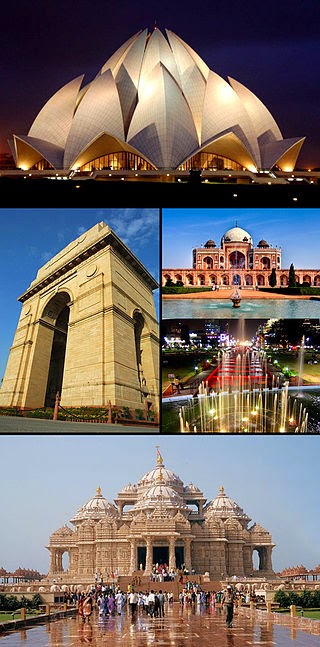 |
| A panoramic picture of a farm in India |
Recently
Today, India is ranked second worldwide in the "farm world". Although agriculture is one of the broadest economic sector and has a massive role in the overall socioeconomic fabric of India as a whole. India also contributes a significant figure to the Gross Domestic Product (GDP). Sustainable agriculture, in terms of food security, rural employment, and environmentally sustainable technologies such as soil conservation, sustainable natural resource management and biodiversity protection, are essential for holistic rural development. Indian agriculture and allied activities have witnessed a green revolution, a white revolution, a yellow revolution and a blue revolution (India.gov).
Major Crops & Farms
In India, it is a large producer of various fruits, rice, wheat, vegetables, major spices and much more. Farms in rural India are usually small plots or smaller fields. In the recent decades, the agriculture in India has doubled in that time span. India also has a great "cash crop", such as cotton and coffee. For example, in 2009, India has the third largest producer of oranges, beans, peas and eggs. The Indian culture has a very diverse agriculture which can range from very poor parts and very developed modern farm villages.
 |
Various crops across India
|
Challenges
Three agriculture sector challenges will be important to India’s overall development and the improved welfare of its rural poor:
1. Raising agricultural productivity per unit of land: Raising productivity per unit of land will need to be the main engine of agricultural growth as virtually all cultivable land is farmed. Water resources are also limited and water for irrigation must contend with increasing industrial and urban needs. All measures to increase productivity will need exploiting, amongst them: increasing yields, diversification to higher value crops, and developing value chains to reduce marketing costs.
2. Reducing rural poverty through a socially inclusive strategy that comprises both agriculture as well as non-farm employment: Rural development must also benefit the poor, landless, women, scheduled castes and tribes. Moreover, there are strong regional disparities: the majority of India’s poor are in rain-fed areas or in the Eastern Indo-Gangetic plains. Reaching such groups has not been easy. While progress has been made - the rural population classified as poor fell from nearly 40% in the early 1990s to below 30% by the mid-2000s (about a 1% fall per year) – there is a clear need for a faster reduction. Hence, poverty alleviation is a central pillar of the rural development efforts of the Government and the World Bank.
3. Ensuring that agricultural growth responds to food security needs: The sharp rise in food-grain production during India’s Green Revolution of the 1970s enabled the country to achieve self-sufficiency in food-grains and stave off the threat of famine. Agricultural intensification in the 1970s to 1980s saw an increased demand for rural labor that raised rural wages and, together with declining food prices, reduced rural poverty. However agricultural growth in the 1990s and 2000s slowed down, averaging about 3.5% per annum, and cereal yields have increased by only 1.4% per annum in the 2000s. The slow-down in agricultural growth has become a major cause for concern. India’s rice yields are one-third of China’s and about half of those in Vietnam and Indonesia. The same is true for most other agricultural commodities.
Policy makers will thus need to initiate and/or conclude policy actions and public programs to shift the sector away from the existing policy and institutional regime that appears to be no longer viable and build a solid foundation for a much more productive, internationally competitive, and diversified agricultural sector (World Bank).

Conclusion
In conclusion, India has an excellent agriculture for its time, and it seems to only be growing. Although India is known for being extremely poor, not too many people understand that we get many spices and food sent over from this lovely country.
References:
http://www.worldbank.org/en/news/feature/2012/05/17/india-agriculture-issues-priorities
http://tejas.iimb.ac.in/interviews/12.php































